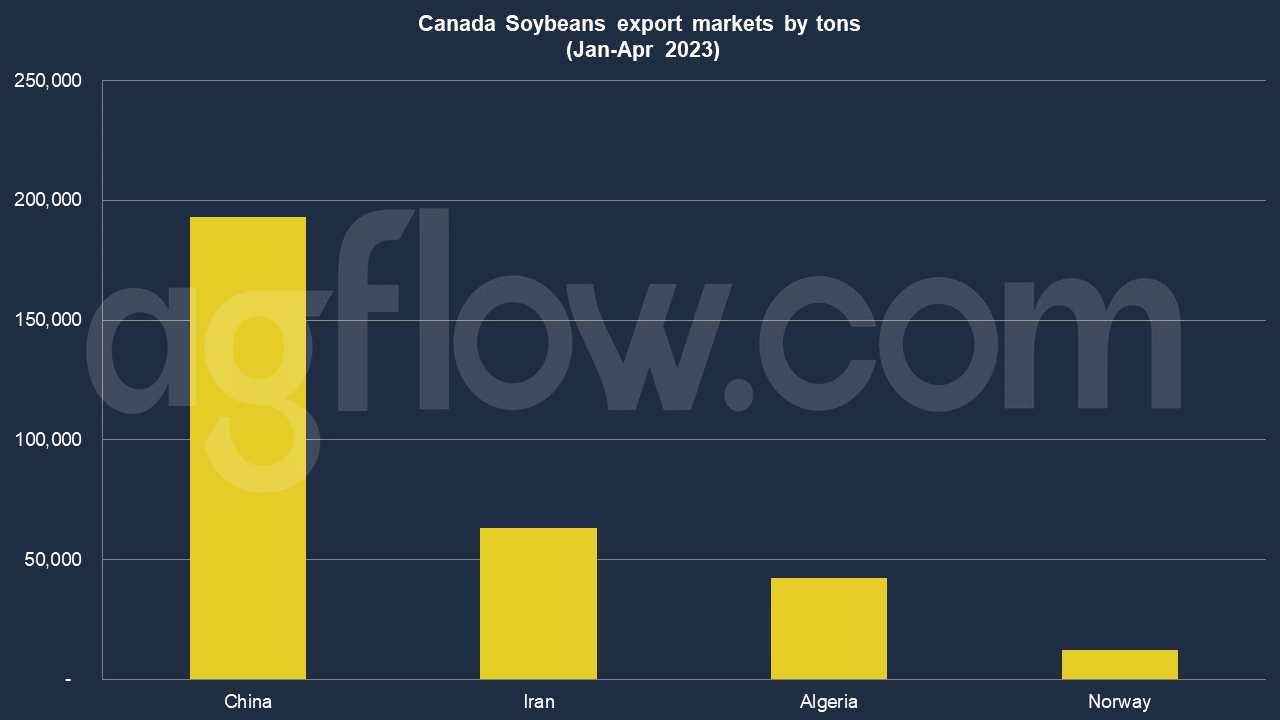Canada Soybeans Export: Chinese Market Recovers Well
Reading time: 2 minutes
Canadian farmers have grown Soybeans for more than 70 years, and recent advances in plant breeding are spurring a new surge in production. Soybeans now rank fourth among Canada’s principal crops in terms of acreage. This growth has been driven by the development of new early-maturing Soybean varieties that are expanding the boundaries of where the crop can thrive. Until the 1970s, almost all of Canada’s Soybeans were grown in southern Ontario. Today Soybeans have become an essential crop in Quebec and Manitoba, as well as parts of the Maritimes, southeast Saskatchewan, and southern Alberta.
In MY 2022/23, Canadian farmers are forecast to plant more Soybeans, as indicated by a continuation of strong prices and lower winter wheat planting than the previous year. Industry sources state that Eastern Canada is particularly vulnerable to Russia’s ban on nitrogen exports as most of Ontario’s nitrogen supply is typically imported from Russia. Shortages may have damaging effects on Soybean yield and quality.
A high-yielding Soybean crop in Ontario requires a tremendous amount of nitrogen (N) – up to 200 to 300 lbs. per acre, according to the Ontario Ministry of Agriculture, Food and Rural Affairs (OMAFRA). In MY 2021/22, Canada’s Soybean production inched lower on smaller yields in Manitoba and Quebec. Manitoba, the province with the second-largest Soybean growing area, saw yields fall to 1.82 tons per hectare in MY 2021/22 from 2.5 tons per hectare the previous year due to extreme drought.
At the same time, and despite a prolonged wet harvest period, Ontario Soybean yields reached a new record of 3.47 tons per hectare. The area planted in Ontario was up three percent from the previous year, and production increased by 4.4 percent.

Soybean Trade in Canada
Traditionally, Canada has exported top-quality food-grade Soybeans with specialty traits for edamame, tofu, soy sauce, and miso. The industry continues to serve this premium market while rapidly increasing its production of commodity Soybeans for processing into soy protein, vegetable oil, animal feed, and a growing range of industrial products.
Nearly two-thirds of the Soybeans grown in Canada are destined for export markets, either as raw Soybeans or processed for end use. The Canadian industry works closely with customers around the world to ensure their needs for quality and composition are met. Most Canadian Soybeans are then delivered to one of Canada’s sizeable coastal shipping ports for export to offshore markets. The remaining Soybeans are transported to Canadian processing plants for transformation into meal and oil and then end-use products for the consumer and industrial markets.
Regulation and quality control are also essential to the industry. Organizations like the Canadian Grain Commission oversee testing and monitoring to ensure high standards are met for all customers. The impact of this activity extends all through the Canadian economy. Through Soy Canada, all industry partners are working together to maximize the progress and value of the industry.
Due to the low exportable supplies, relative to recent years, export volumes to nearly every primary importing market are down but rose in Pakistan, Indonesia, and Egypt. The equivalent of approximately 65 percent of Canada’s MY 2021/2022 production was projected to be exported around the world. Since MY 2019/20, Iran has displaced China as the single largest importer of Canadian Soybeans. China’s Canadian Soybeans purchases plunged by 95 percent that year and have yet to recover.
According to the AgFlow data, China led its export market with 0.2 million tons of Soybeans in Jan-Apr 2023, followed by Iran (63,000 tons), Algeria (42,421 tons), and Norway (12,000 tons). In MY 2022/2023, Export volumes are forecast to increase on an expansion of exportable supplies and strong global demand for oilseeds. Imports of Soybeans remain limited by Soybean processing capacity. Most Soybean commodity volume is imported in meal form for animal feed.
Other sources: SOY CANADA
Try AgFlow Free
Access Free On Updates for Corn, Wheat, Soybean,
Barley, and Sunflower Oil.
No Credit Card Required & Unlimited Access In Time

